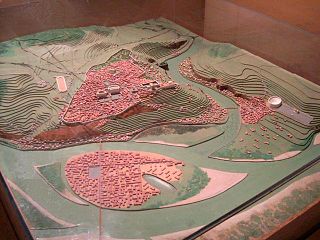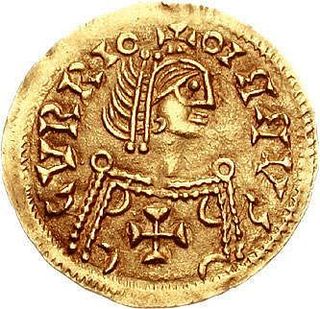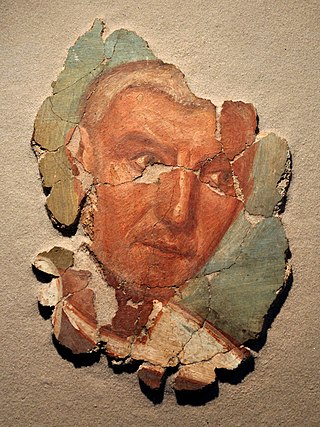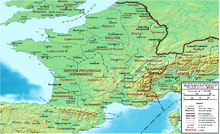History
The diocese was established during the reforms of Diocletian who reigned from 284-305. It is attested early in the reign of Constantine I in the Verona List which has been dated to around 314. In 402 an annual provincial assembly, the Concilium septem provinciarum , was established in Arles.
In 407, the Vandals and their allies invaded Gaul, devastating the region until they departed for the Iberian peninsula in 409. The Visigoths were brought in as foederati to aid the Romans against them, and in 418 emperor Honorius allowed them to settle in Aquitania around Toulouse. Although nominally Roman subjects, the Goths were practically independent, a fact which was formally recognized by the Western Empire in 475, just one year before its end.
In 462 Ricimer ceded them also the province of Narbonensis Prima, while the Goths proceeded to occupy the remaining provinces east of the Rhone in 477. Henceforth, the lands that had comprised the diocese of the Seven Provinces became part of the Visigothic Kingdom. Aquitania was soon lost to the Franks, with only the southern coastal strip (Septimania) retained by the Goths.

Honorius was Roman emperor from 393 to 423. He was the younger son of emperor Theodosius I and his first wife Aelia Flaccilla. After the death of Theodosius, Honorius ruled the western half of the empire while his brother Arcadius ruled the eastern half. In 410, during Honorius's reign over the Western Roman Empire, Rome was sacked for the first time in almost 800 years.

Gaul was a region of Western Europe first described by the Romans. It was inhabited by Celtic and Aquitani tribes, encompassing present-day France, Belgium, Luxembourg, most of Switzerland, parts of Northern Italy, and Germany west of the Rhine. It covered an area of 494,000 km2 (191,000 sq mi). According to Julius Caesar, Gaul was divided into three parts: Gallia Celtica, Belgica, and Aquitania. Archaeologically, the Gauls were bearers of the La Tène culture, which extended across all of Gaul, as well as east to Raetia, Noricum, Pannonia, and southwestern Germania during the 5th to 1st centuries BC. During the 2nd and 1st centuries BC, Gaul fell under Roman rule: Gallia Cisalpina was conquered in 204 BC and Gallia Narbonensis in 123 BC. Gaul was invaded after 120 BC by the Cimbri and the Teutons, who were in turn defeated by the Romans by 103 BC. Julius Caesar finally subdued the remaining parts of Gaul in his campaigns of 58 to 51 BC.

The Gallic Empire or the Gallic Roman Empire are names used in modern historiography for a breakaway part of the Roman Empire that functioned de facto as a separate state from 260 to 274. It originated during the Crisis of the Third Century, when a series of Roman military leaders and aristocrats declared themselves emperors and took control of Gaul and adjacent provinces without attempting to conquer Italy or otherwise seize the central Roman administrative apparatus.

Septimania is a historical region in modern-day Southern France. It referred to the western part of the Roman province of Gallia Narbonensis that passed to the control of the Visigoths in 462, when Septimania was ceded to their king, Theodoric II. The region was also variously known as Gallia, Arbuna or Narbonensis. The territory of Septimania roughly corresponds with the modern French former administrative region of Languedoc-Roussillon that merged into the new administrative region of Occitanie. Septimania was conquered by the Muslims in the 8th century, when it was known as Arbuna and was made part of Al-Andalus. It passed briefly to the Emirate of Córdoba, which had been expanding from the south during the eighth century, before its subsequent conquest by the Franks, who by the end of the ninth century termed it Gothia or the Gothic March.

The Roman provinces were the administrative regions of Ancient Rome outside Roman Italy that were controlled by the Romans under the Roman Republic and later the Roman Empire. Each province was ruled by a Roman appointed as governor.

Gallia Aquitania, also known as Aquitaine or Aquitaine Gaul, was a province of the Roman Empire. It lies in present-day southwest France, where it gives its name to the modern region of Aquitaine. It was bordered by the provinces of Gallia Lugdunensis, Gallia Narbonensis, and Hispania Tarraconensis.

Gallia Narbonensis was a Roman province located in what is now Languedoc and Provence, in Southern France. It was also known as Provincia Nostra, because it was the first Roman province north of the Alps, and as Gallia Transalpina, distinguishing it from Cisalpine Gaul in Northern Italy. It became a Roman province in the late 2nd century BC. Gallia Narbonensis was bordered by the Pyrenees Mountains on the west, the Cévennes to the north, the Alps on the east, and the Gulf of Lion on the south; the province included the majority of the Rhone catchment. The western region of Gallia Narbonensis was known as Septimania. The province was a valuable part of the Roman Empire, owing to the Greek colony of Massalia, its location between the Spanish provinces and Rome, and its financial output.

Gaius Pius Esuvius Tetricus was the emperor of the Gallic Empire from 271 to 274 AD. He was originally the praeses (governor) of Gallia Aquitania and became emperor after the murder of Emperor Victorinus in 271, with the support of Victorinus's mother, Victoria. During his reign, he faced external pressure from Germanic raiders, who pillaged the eastern and northern parts of his empire, and the Roman Empire, from which the Gallic Empire had seceded. He also faced increasing internal pressure, which led him to declare his son, Tetricus II, caesar in 273 and possibly co-emperor in 274, although this is debated. The Roman emperor Aurelian invaded in 273 or 274, leading to the Battle of Châlons, at which Tetricus surrendered. Whether this capitulation was the result of a secret agreement between Tetricus and Aurelian or necessary after his defeat is debated. Aurelian spared Tetricus, and even made him a senator and corrector (governor) of Lucania et Bruttium. Tetricus died of natural causes a few years after 274.

Praeses is a Latin word meaning "placed before" or "at the head". In antiquity, notably under the Roman Dominate, it was used to refer to Roman governors; it continues to see some use for various modern positions.

Lugdunum was an important Roman city in Gaul, established on the current site of Lyon. The Roman city was founded in 43 BC by Lucius Munatius Plancus, but continued an existing Gallic settlement with a likely population of several thousands. It served as the capital of the Roman province of Gallia Lugdunensis and was an important city in the western half of the Roman Empire for centuries. Two emperors, Claudius and Caracalla, were born in Lugdunum. In the period 69–192 AD, the city's population may have numbered 50,000 to 100,000, and possibly up to 200,000 inhabitants.

Roman Italy was the homeland of the ancient Romans. According to Roman mythology, Italy was the ancestral home promised by Jupiter to Aeneas of Troy and his descendants, Romulus and Remus, who were the founders of Rome. Aside from the legendary accounts, Rome was an Italic city-state that changed its form of government from Kingdom to Republic and then grew within the context of a peninsula dominated by the Gauls, Ligures, Veneti, Camunni and Histri in the North, the Etruscans, Latins, Falisci, Picentes and Umbri tribes in the Centre, and the Iapygian tribes, the Oscan tribes and Greek colonies in the South.

Roman Gaul refers to Gaul under provincial rule in the Roman Empire from the 1st century BC to the 5th century AD.
The Laterculus Veronensis or Verona List is a list of Roman provinces and barbarian peoples from the time of the emperors Diocletian and Constantine I, most likely from AD 314.

The Visigothic Kingdom, officially the Kingdom of the Goths, was a kingdom that occupied what is now southwestern France and the Iberian Peninsula from the 5th to the 8th centuries. One of the Germanic successor states to the Western Roman Empire, it was originally created by the settlement of the Visigoths under King Wallia in the province of Gallia Aquitania in southwest Gaul by the Roman government and then extended by conquest over all of Hispania. The Kingdom maintained independence from the Eastern Roman or Byzantine Empire, whose attempts to re-establish Roman authority in Hispania were only partially successful and short-lived.

The Diocese of Gaul was a diocese of the later Roman Empire, under the praetorian prefecture of Gaul. It encompassed northern and eastern Gaul, that is, modern France north and east of the Loire, including the Low Countries and modern Germany west of the Rhine.

Gallo-Roman culture was a consequence of the Romanization of Gauls under the rule of the Roman Empire. It was characterized by the Gaulish adoption or adaptation of Roman culture, language, morals and way of life in a uniquely-Gaulish context. The well-studied meld of cultures in Gaul gives historians a model against which to compare and contrast parallel developments of Romanization in other less-studied Roman provinces.
Viennensis or Gallia Viennensis was a Late Roman province that derived its name from its capital Vienna, a Roman city, first located in Gallia Narbonensis.

The Notitia Galliarum is a Roman register of cities dating to the 4th–6th centuries AD. The Latin register is divided into two headings. Ten provinces are listed under the diocese of Gaul and seven under the diocese of the Seven Provinces. For each province the capital city is given and then its other cities (civitates). They are given their ethnic names, i.e., "city of [people]". A total of 115 cities are listed along with six or seven castra (forts) and one portus (harbour).
The Gallic Alps were an ancient cultural region located in the Alps and populated mainly by Gauls. The term Celtic Alps is also found in ancient Greek texts.
















